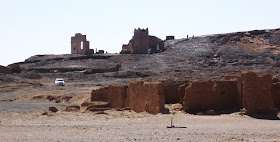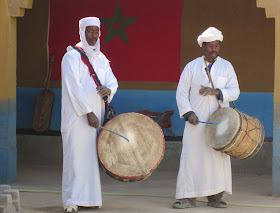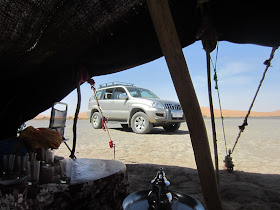Other than pretending to be Lawrence and Laurie of Arabia, what does one DO in the Sahara Desert for two full days? Well, there is a surprisingly wide variety of things to see and do.
1. DAR GNAOUA (AKA "GNAWA")
Descendants of slaves taken from West Africa--Mali, Ghana, etc.--have established a little colony called "Khamlia" at the edge of the desert. I loved the wikitravel entry for this place, which at the moment I am writing this post reads:
You can take a promenade through the village, visit Berber family who will be happy for you. You are welcome also to visit the school, talk with children, play football with them. To go to the sand dunes is relaxing and exciting too. In opposite site is open area here and you can see even so far as to mountain. Of course, you will find here the famous music group Gnawa. Their music is ritual music and communicates with mystery. They will play for you anytime you wish. Take a tea and listen. If you have 4x4 you can go to M´Fis, it is mineral mines and it is very interesting to see, how the worker works there.
We were the only guests, and when we first entered, the walled village was eerily quiet and seemed empty--almost like a ghost town--but a very well-maintained ghost town.
We walked around the roofed interior perimeter, which reminded me of the cloisters walk in a monastery or convent. Hanging on the walls were several pieces of original art that I believe were for sale:
After a bit, a group of Gnawa men came out to do a private performance for us. These people are primarily Sufis, the mystical, ritualistic branch of Islam. Their culture centers around music and dance, and it was very fun to listen to and see several ritualistic numbers:
All of the performers were men, but we could see the women doing a variety of chores in the complex. I loved their unique white djellabas and crown-like rolled hats:
I wouldn't say they are especially talented dancers OR singers, but then what do I know? They sure were fun to watch and listen to.
As I looked at them and contemplated what their day-to-day life was like, I wonder if they were looking at us with the same thoughts?
 |
| Note the Moroccan flag on the wall and the two kinds of shoes they are wearing: leather sandals and very traditional pointy-toed Moroccan slippers. |
2. COBALT MINE
My vision of the Sahara had come from Hollywood and was mostly images of broad expanses of sand ranging in color from beige to coral and sweeping up and down hills that blocked the view of any possible salvation from scorching heat and wind.
I was surprised to learn that much of the Sahara looks like this:
At times the desert seemed to swallow the road, but Hassan, owner of Merzouga Bivouac Experience and our driver for the day, didn't need roads.
An entrance of sorts was still visible:
Hassan told us it was a cobalt mine, and while we didn't find any cobalt lying around on the surface, we saw plenty of rocks that looked a little out of place:
Within minutes of our arrival at the site, two men selling bric-a-brac came hurrying up to meet us. Although we had bypassed the same type of merchandise when our driver had stopped at a "museum" (aka "shop") along the road the day before, we succumbed to the atmosphere of the place and their persistence and bought two small stone salt cellars with fossils of snails on the lids and a soap dish with a similar fossil. The area is known for its fossils, and these appear to be authentic. We did minimal bargaining and paid 200 dirham (about $20), which we knew was way too much, but tourism in this region is WAY down, and we figured we probably fed a family for a month:
3. ANCIENT MTIS
Hassan continued to give us a wild ride in his nice 4x4 Jeep. He told us the next stop was the Algerian border, where he would drop us off for a few hours and come back later. He got a good laugh out of that, but it did make me a little nervous to be so close to the border. Morocco and Algeria aren't exactly best friends right now.
Ah, this was better--11th century ruins precariously perched in the sand, waiting for the next sandstorm to bury them:
Hassan called this "Mitheast Village," but a map of the area labels it "Mtis":
Bob wanted to get out and walk around, and Hassan let him out to take some pictures but told him he would have to stay on the "road" (such as it was) and not to wander into the structures. Hassan actually seemed a bit nervous. What? Was the place haunted?
The crumbling thousand-year-old adobe certainly had an eerie quality. Who lived here? How did they survive?
Of course, we had to wonder if these ruins really were 11th century vintage. Is it possible to survive the windstorms of the Sahara for that long?
But then, some of the structures were so worn that they looked like bizarre geologic formations:
Surprisingly, we came upon a building with glass windows and a wooden door:
"A mosque," Hassan told us.

A mosque? For whom? Who would live in this god-forsaken place?
Soldiers, that's who. They have turned this area into a military base because of its proximity to Algeria.

Aha! That explained Hassan's reluctance to let us explore inside the ruins themselves. We might turn into target practice.
Personality-wise, Hassan was ebullient, and he was unmistakable and unforgettable in his peacock and apricot robe with matching turban. He was absolutely overflowing (no pun intended) with pride as he showed us this well "right here in the Sahara Desert":
Hassan said the well was dug by locals, but the sign on top identifies a non-profit French company named "Couer de Gazelles" as the builders.
A well like this is a huge asset to the locals, who use it to water both their livestock and themselves. The well walls are 1 meter sections placed one row at a time. Each section of the wall takes 2 to 3 days to place, connect with concrete, and dry.
The water is only 8 meters (26 feet) below the surface. Hassan showed us the high-tech system for bringing up water:
The water looked very clean, and I figured it had been filtered through the fine sand of the Sahara, so I scooped a bit into my hand and tasted it without really thinking it through first. I think I shocked my husband, who was not willing to take the same risk himself. I must say that after I tasted it, I had some regrets. While cool, it wasn't the sweet water of a mountain stream, but bitter water that tasted like desert shrubs had been marinating in it for decades:
5. BEDOUIN TENT VISIT
Now that I had experienced "glamping" in the Sahara, it was time to see what REAL tent camping was all about. Comparing our luxury tent to the nomad/Bedouin experience is like comparing Hollywood love stories to real life. Have you noticed how the movie heroine always seems to have perfect make-up and hair, no matter the circumstances? Who looks like that after three harrowing days in the wilderness, or a shipwreck--or whatever the plot may have been?
Luxury tent camping is certainly not the real world of the Sahara, where the temperature can reach 130 degrees in the summer months. It's a facade--a wonderful one, but a facade nevertheless. I suspect that the Bedouin tent camp we saw was also a bit of a facade. It was frequented by tourists, which meant that the inhabitants had a source of income other than herding goats. The "yard" was neat and tidy, unlike most of the Bedouin camps we drove by in other places.
This particular compound had several structures, including the main tent:
. . . and several of whatever these are. (Maybe they are where you are sent if you misbehave?)
.
There was a mud hut kitchen that didn't look at all like the kitchen in our luxury camp, and even less like any American kitchen, even the ghetto kitchen we had when we were starving students:
However, it did have a nice tin teapot:
. . . and some salted chicken hanging from the rafters. This chicken can be kept like this for up to a month in the cooler seasons.
Here is one little goat who got left behind.

Of course, any Moroccan worth their salt, even a Bedouin, has to serve guests tea (or in our case, water or milk and sugar). They had a special tent for that too. Aziz, who had driven us from Fes to Merzouga, was out on the drive with us. He is the man in the picture below:
Aziz and Bob:
Hassan relaxes while the Bedouin woman prepares tea. Her head scarf covered everything but her eyes. We noticed that the southern desert region of Morocco, a lot more women wear the full veil than in the big cities. There were also a lot of women dressed in black from head to toe with only the eyes uncovered, burqa style.
She also served wedges of Morocco's ubiquitous dry, tough bread. Oh goodie.
Yes, that's a soccer ball back there in the corner:

The contrasts could even be seen in the funky decor, which included a camel woven from reeds and an unidentifiable stuffed animal with a tag that read "Monsterous":
And of course, there's that luxury 4x4 parked just outside the Bedouin tent on the Sahara sand:
6. FOUR-WHEELIN'
After thanking our lovely hostess the best we could, which meant saying shukraan ("Thank you" in Arabic) over and over and leaving a nice tip, we got back into the car and headed back into the desert. How does anyone find their way around this place?
We saw a lot of these gourds on dead-looking vines, and Bob asked Hassan to stop so he could take a closer look:
No thank you. I think I'll wait for lunch:
At another stop we were met by a mini-mall's worth of vendors who must have heard about our extravagant purchase at the mine earlier in the day. Word travels fast in this region. Sorry, guys. We only have so much suitcase space




























































A weird, but enjoyable day in the desert. Of all that we saw, I think the little tents in the desert on hard-scrabble, and women herding goats, is what I'll remember. A very tough existence.
ReplyDeleteI can't imagine living in the area of those ruins with the endless sand blowing in your face everyday. Who would pick such a place to build a city?
ReplyDeleteI like that bright blue clothing of your guide.